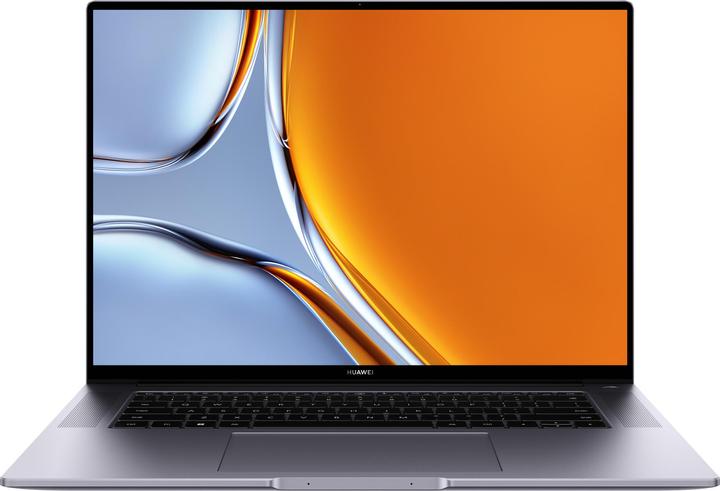

Huawei MateBook 16s review: big 3:2 display and plenty of power
With its 16-inch 3:2 screen, the new Huawei MateBook shows more content while still having that compact and light edge.
The MateBook 16s doesn’t just boast a large display. It also packs in a load of power thanks to the 12th generation Intel Core i9. But when it comes to really demanding tasks, you notice the lack of a graphics card.

The specs
- Processor: Intel Core i9-12900H
- Integrated graphics processor: Intel Iris X
- RAM: 16 GB LPDDR5
- Storage: 1 TB NVMe PCIe SSD
- Display: 16-inch IPS, 3:2, 2520 × 1680 pixel, touchscreen
- Keyboard: backlit and full-frame
- Ports and slots: 2 × USB-A (3.2 Gen 1), 2 × USB-C (1 × with Thunderbolt 4, both DisplayPort, data and charging), 1 × HDMI, 1 × 3.5 mm audio
- Audio: stereo speakers
- Camera: full-HD webcam
- Connectivity: Wi-Fi 6E, Bluetooth 5.2
- Operating system: Windows 11 Home
- Dimensions: 351 × 245.9 × 17.8 mm
- Battery: 84 Wh lithium-ion battery
Design and ports
The MateBook 16s features plain and elegant metal casing. It’s sleek, matt and only available in Space Grey. While the device is big at 351 × 254.9 mm, it’s still comfortably slim at no more than 17.8 mm. To give you an idea of size: the MateBook easily fits into my rucksack laptop compartment, which is designed for 15-inch devices. Weighing in at 2 kg, it’s no lightweight, but still feels like it by virtue of its size.
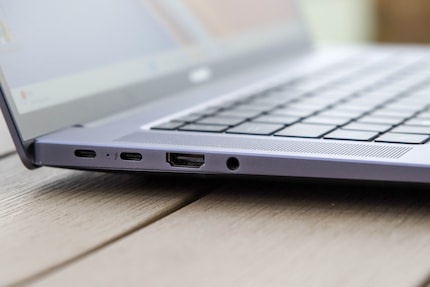
Source: Jan Johannsen
In terms of ports, the MateBook 16s is well equipped. There are two USB-A ports on the right-hand side (3.2 Gen 1). Meanwhile, the left side is home to a 3.5-mm headphone jack, HDMI, Thunderbolt 4 (USB-C) and USB-C port. As for wireless transmission standards, the device is well served with Wi-Fi 6 and Bluetooth 5.2.
Display: size as an advantage
The MateBook 16s clearly demonstrates the benefits of a screen with a 3:2 aspect ratio. Compared with your average 16:9 or 16:10 format, there’s more to play with. It means less scrolling, allowing you to see more at first glance. That’s why I like to opt for black bars when I’m playing videos. The 2,520 × 1,680 pixel resolution provides a comfortable 189 ppi pixel density on the 16-inch screen.
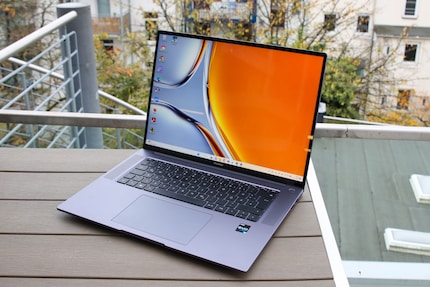
Source: Jan Johannsen
The IPS display has a narrow frame, which only takes up 10% of the inside of the notebook lid. That lets the screen cover the remaining 90%. At 178 degrees, the angle of view is standard. The 300-Nit brightness is at the limit of what could be described as high. When combined with the 1,500:1 contrast ratio, it makes content on the screen easy to view in daylight. However, the screen isn’t matt and does reflect sunlight and lamps. Unfortunately, that’s what permanently disqualifies the Matebook as a work tool for me. If colour space is a key factor for you, the MateBook 16s is meant to cover up to 100% of sRGB. And the display is touchscreen.
Keyboard without a number pad but with a big touchpad
A big screen also translates as more space for the keyboard and touchpad. When it comes to the Matebook 16s, Huawei doesn’t use this real estate for a number pad, which I was thrilled about. Instead, there are speakers next to the keyboard. Moving onto the keys, they’re backlit, pleasantly large and allow for precise typing. Meanwhile, the 1.5-mm key stroke is short and you can clearly feel the pressure point.

Source: Jan Johannsen
The touchpad underneath the keyboard is big and reacts unfailingly. That’s good in some ways. But not so much in others. On the train, the ball of my thumb often brushes over the touchpad, which it falsely interprets as my finger.
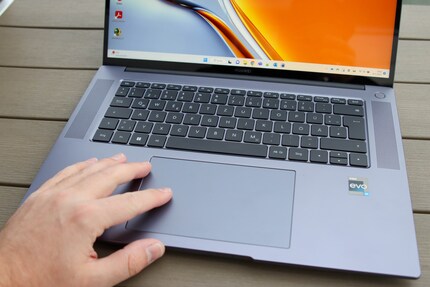
Source: Jan Johannsen
Huawei integrated a fingerprint sensor into the power button, which locks the notebook as you switch it off.
Speakers and webcam
The two MateBook 16s speakers are located on the right and left of the keyboard, meaning the sound channels straight in your direction. As far as notebook speakers go, they don’t sound bad – even though the bass turns out to be subtle. Ultimately, they’re just laptop speakers. But they’re good enough for video calls, playing Internet videos or background music. These speakers are blooming loud, without the clanging sound that can come with it.
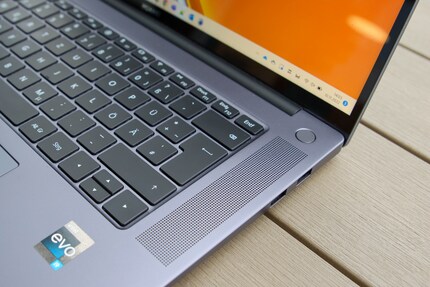
Source: Jan Johannsen
The full HD webcam is usable for video calls, but it doesn’t blow you away. Most selfie cameras on smartphones boast a greater resolution along with improved light sensitivity.
Windows 11 Home with superb device software
Windows 11 Home is installed on the MateBook 16s. And Huawei completes the operating system with its «super device» set-up. If you use other Huawei devices, such as smartphones or tablets, this lets you connect them to each other. It enables you to exchange files or partially control your smartphone from the notebook.
Battery
The MateBook 16s contains a lithium-ion battery with a capacity of 84 Wh. In other words, the battery can hold out for 7 hours and 15 minutes of non-stop YouTube streaming, with screen brightness cranked up to the max. That’s good but nothing to write home about. The values indicate a runtime of 5.17 minutes per watt-hour. As a result, the Huawei notebook fares worse than the LG Gram 17, which clocked up 7.3 minutes per watt-hour – based on a similar-sized display and battery.
Performance
With the Core i9-12900H, Huawei is opting for the highest standard of Intel’s current chip generation. It features more than six performance- and eight efficiency cores, giving a total of 14 as well as 20 threads. Next to that, 16 GB of RAM and the integrated Iris-X graphics card seem almost underpowered.
Processor
Maxon’s Cinebench tests how well a processor performs when rendering 3D models. In the R23 version, the CPU benchmark determines the point value of work accomplished within ten minutes. As a result, poor cooling concepts perform more realistically than when there’s just one – usually shorter – test run.
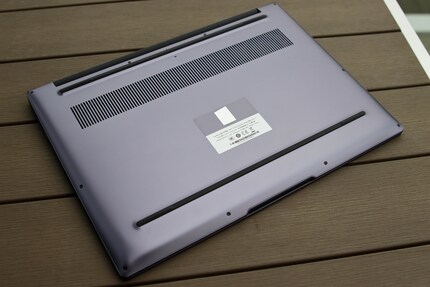
Source: Jan Johannsen
As a second processor benchmark, I use Geekbench 5. Based on simulated, real-life scenarios, the CPU is tested for single-core and multi-core use. Testing only takes a short time and can therefore lead to relatively good results even with poorly cooled devices. The benchmark runs on Windows, MacOS, Linux, Android and iOS. This also makes cross-comparisons possible, even though they should be taken with a pinch of salt.
| Single core | Multi core | |
|---|---|---|
| Cinebench 23 | 1849 points | 13563 points |
| Geekbench 5 | 1882 points | 12891 points |
The results of the Core i9-12900H in the MateBook 16s are excellent. The proof of the pudding is in the notebook comparison that my colleague Martin Jud carried out.
| Benchmark | Result: Microsoft Surface Laptop 5
(i5-1235U, 10 Cores, 12 Threads) | Result: Microsoft Surface Laptop 4
(i7-1185G7, 4 Cores, 8 Threads) | Result: Microsoft Surface Laptop 4
(Ryzen 7 4980U, 8 Cores, 16 Threads) | Result: Dell XPS 13 Plus
(i5-1240P, 12 Cores, 16 Threads) | Result: Lenovo Yoga 9i
(i7-1260P, 12 Cores, 16 Threads) |
|---|---|---|---|---|---|
| Cinebench R23 – CPU Multi Core | 6556 points | 4727 points | 8028 points | 6829 points | 10,094 points |
| Cinebench R23 – CPU Single Core | 1598 points | 1523 points | 1286 points | 1613 points | 1651 points |
| Geekbench 5 – CPU Multi Core | 8565 points | 5721 points | 7241 points | 7177 points | 10,326 points |
| Geekbench 5 – CPU Single Core | 1576 points | 1556 points | 1175 points | 1611 points | 1742 points |
Even the Core i9-12900H easily upstages the current Core i7-1260P in the Lenovo Yoga 9i. Although the distinction is less in single core than in multi-core mode.
Graphics
Intel’s integrated graphics chip Iris X scores 20,634 points in the OpenCL test in Geekbench 5 and 19,320 points in the Vulkan test. To put this into perspective, the Intel Iris X in the last eleven processor generations only reached 18,811 (OpenCL) and 14,728 points respectively with the LG Gram 17. Meanwhile, the current variant has increased in both graphics interfaces, with Vulkan benefiting more.
Verdict: not perfect, but very good
Huawei has put together a nice and powerful notebook in the form of the MateBook 16s. With its Core i9-12900H, the device is even the cheapest model we have. However, competitors usually combine the processor with a dedicated graphics card. And that reveals one of the MateBook’s problems. While the Core i9 equips the device well for standard office use, it lacks graphics power for more demanding tasks.
I enjoyed using Huawei’s notebook with its computing power and excellent finish. But I’d certainly also look for cheaper models with a Core i7 or i5 that would tick the boxes for what I need, including image editing in Lightroom. The user-friendly controls and, in particular, the display size to weight ratio make the MateBook 16s a laptop I’d like to use. That’s in spite of the fact the variety of ports and battery life are just average. But what remains a turn-off – at least for long spells of work – is the reflective display.
When I was but a young student, I'd sit in my friend's living room with all my classmates and play on his SuperNES. Since then I've had the opportunity to test out all the newest technology for you. I've done reviews at Curved, Computer Bild and Netzwelt, and have now arrived at Galaxus.de.


